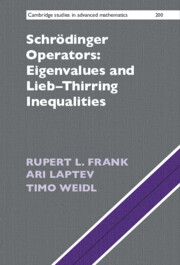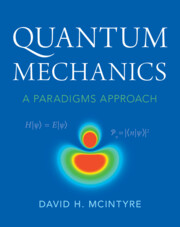53 results
29 - Coupled Systems and Diagonalisation
-
- Book:
- Mathematics for Economics and Finance
- Published online:
- 24 May 2024
- Print publication:
- 30 May 2024, pp 334-346
-
- Chapter
- Export citation
5 - Linear Dynamics
-
- Book:
- Offshore Wind Energy
- Published online:
- 07 March 2024
- Print publication:
- 14 March 2024, pp 168-183
-
- Chapter
- Export citation
5 - Review of Mathematical and Statistical Concepts
-
- Book:
- Data Science for the Geosciences
- Published online:
- 25 August 2023
- Print publication:
- 17 August 2023, pp 204-239
-
- Chapter
- Export citation
Limiting empirical spectral distribution for the non-backtracking matrix of an Erdős-Rényi random graph
- Part of
-
- Journal:
- Combinatorics, Probability and Computing / Volume 32 / Issue 6 / November 2023
- Published online by Cambridge University Press:
- 31 July 2023, pp. 956-973
-
- Article
-
- You have access
- Open access
- HTML
- Export citation
REILLY-TYPE UPPER BOUNDS FOR THE p-STEKLOV PROBLEM ON SUBMANIFOLDS
- Part of
-
- Journal:
- Bulletin of the Australian Mathematical Society / Volume 108 / Issue 3 / December 2023
- Published online by Cambridge University Press:
- 28 February 2023, pp. 492-503
- Print publication:
- December 2023
-
- Article
- Export citation
2 - Two Reflections
-
- Book:
- Discrete Quantum Walks on Graphs and Digraphs
- Published online:
- 23 December 2022
- Print publication:
- 12 January 2023, pp 11-19
-
- Chapter
- Export citation
Overview
-
- Book:
- Schrödinger Operators: Eigenvalues and Lieb–Thirring Inequalities
- Published online:
- 03 November 2022
- Print publication:
- 17 November 2022, pp 1-4
-
- Chapter
- Export citation
1 - Elements of Operator Theory
- from Part One - Background Material
-
- Book:
- Schrödinger Operators: Eigenvalues and Lieb–Thirring Inequalities
- Published online:
- 03 November 2022
- Print publication:
- 17 November 2022, pp 7-65
-
- Chapter
- Export citation

Schrödinger Operators: Eigenvalues and Lieb–Thirring Inequalities
-
- Published online:
- 03 November 2022
- Print publication:
- 17 November 2022
4 - Eigenvalues of the Fractional p-Laplacian
-
- Book:
- Fractional Sobolev Spaces and Inequalities
- Published online:
- 06 October 2022
- Print publication:
- 13 October 2022, pp 63-74
-
- Chapter
- Export citation
2 - Operators and Measurement
-
- Book:
- Quantum Mechanics
- Published online:
- 11 February 2023
- Print publication:
- 15 September 2022, pp 34-67
-
- Chapter
- Export citation

Quantum Mechanics
- A Paradigms Approach
-
- Published online:
- 11 February 2023
- Print publication:
- 15 September 2022
-
- Textbook
- Export citation
7 - The Second-Order Reliability Method
-
- Book:
- Structural and System Reliability
- Published online:
- 13 January 2022
- Print publication:
- 13 January 2022, pp 185-199
-
- Chapter
- Export citation
Index estimates for closed minimal submanifolds of the sphere
- Part of
-
- Journal:
- Proceedings of the Royal Society of Edinburgh. Section A: Mathematics / Volume 152 / Issue 3 / June 2022
- Published online by Cambridge University Press:
- 17 December 2021, pp. 802-816
- Print publication:
- June 2022
-
- Article
- Export citation
AN EIGENVALUE CHARACTERISATION OF THE DUAL EDM CONE
- Part of
-
- Journal:
- Bulletin of the Australian Mathematical Society / Volume 106 / Issue 1 / August 2022
- Published online by Cambridge University Press:
- 18 November 2021, pp. 67-69
- Print publication:
- August 2022
-
- Article
- Export citation
Concentrated matrix exponential distributions with real eigenvalues
-
- Journal:
- Probability in the Engineering and Informational Sciences / Volume 36 / Issue 4 / October 2022
- Published online by Cambridge University Press:
- 26 August 2021, pp. 1171-1187
-
- Article
- Export citation
Periodic points of post-critically algebraic holomorphic endomorphisms
- Part of
-
- Journal:
- Ergodic Theory and Dynamical Systems / Volume 42 / Issue 7 / July 2022
- Published online by Cambridge University Press:
- 11 May 2021, pp. 2382-2414
- Print publication:
- July 2022
-
- Article
- Export citation
2 - Algebraic Eigenproblems and Their Applications
- from Part I - Matrix Methods
-
- Book:
- Matrix, Numerical, and Optimization Methods in Science and Engineering
- Published online:
- 18 February 2021
- Print publication:
- 04 March 2021, pp 64-154
-
- Chapter
- Export citation
3 - Differential Eigenproblems and Their Applications
- from Part I - Matrix Methods
-
- Book:
- Matrix, Numerical, and Optimization Methods in Science and Engineering
- Published online:
- 18 February 2021
- Print publication:
- 04 March 2021, pp 155-217
-
- Chapter
- Export citation
13 - Coupled Oscillators
- from Part III
-
- Book:
- Modern Classical Mechanics
- Published online:
- 30 November 2020
- Print publication:
- 10 December 2020, pp 530-574
-
- Chapter
- Export citation























